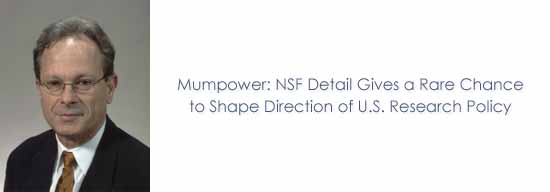
By Joel Blumenthal
Jeryl L. Mumpower had the privilege of seeing and learning how U.S. research funding policy is made. In fact, he even got to make some of it.
Mumpower is currently serving in the Academic Affairs office as associate provost and associate vice president, overseeing the areas of academic information systems and technology and graduate studies. His �regular job� is as a professor in the Department of Public Administration and Policy.
But from 1998–99, Mumpower worked at National Science Foundation (NSF) headquarters in Arlington, Va., as manager of the Decision, Risk and Management Science program in the NSF's Directorate for Social, Behavioral and Economic Sciences. This was his second tour of duty at NSF; he previously worked there from 1980–84 as a program manager and policy analyst.
�It�s a rare and exciting opportunity to be able to shape the direction of the field you're in for years to come,� Mumpower says. Under the NSF�s unique structure, he notes, program officers — the equivalent of faculty members at a university — play the single largest role in determining which research proposals are approved for funding.
Mumpower�s recent NSF tour of duty was under the federal Intergovernmental Personnel Act (IPA) program, which reimburses the employers for the salary of people who go to work temporarily for the federal government. NSF also pays a living allowance to reduce the cost of maintaining a temporary residence, and pays the cost for program officers to return to their home institutions in order to keep up on their research.
While he was director in the 1980s, Erich Bloch dramatically increased the use of the IPA program at NSF. The goal was to bring in �fresh blood,� new ideas and extra energy, yet still save money because the agency did not have to give these employees permanent status and federal benefits. Today, about 40 percent of the 1,200 people at NSF — including assistant directors of the agency — are temporary employees.
Mumpower is surprised that more of his UAlbany colleagues have not taken the same opportunity to work at NSF. According to Associate Vice President for Academic Affairs Bill Hedberg and Assistant Vice President for Research Garrett Sanders (whose office handles the funding, processing and paper work) Mumpower and Mathematics and Statistics Professor Joe Jenkins are the only UAlbany faculty members to have gone on NSF detail in the past several years (Jenkins retired from the University, but stayed as an NSF employee. Professor of Biological Sciences Joseph Mascarenhas was at NSF from 1985–87).
�I would recommend it highly,� says Mumpower. �It�s a good opportunity for people who have experience in their fields to use it, and a good opportunity for people who aren�t that experienced to become better known. You get a great deal of satisfaction from doing community service. The NSF has a very clever system, one that gives program officers a great deal of discretion as they review proposals, yet also ensures that they receive the advice and counsel of their peers from all over the country.�
Mumpower was impressed by the collegiality of NSF — particularly regular weekly brown bag lunches where program officers in the directorate met with, got to know, and learned from others. �It�s like a department meeting, except your department has a much more diverse range of backgrounds and experience,� he says.
Always the behavioral scientist, Mumpower says the best evidence of the value of the NSF system and structure �is in the outcomes — and they have been excellent.�
In fact, the only downside he sees to his tour of duty is that �most of the work is cumulative; you won�t see the results of a particular program or proposal for many years. In that way, nothing you start ever gets finished while you�re there.�
Back 